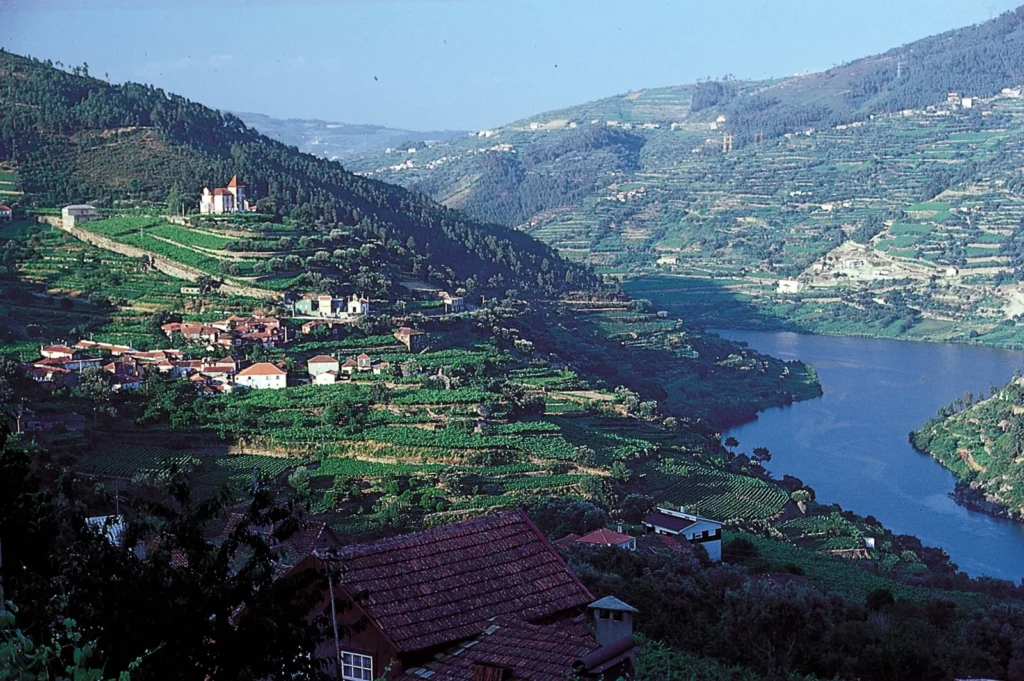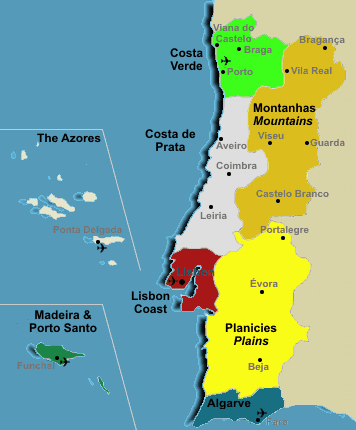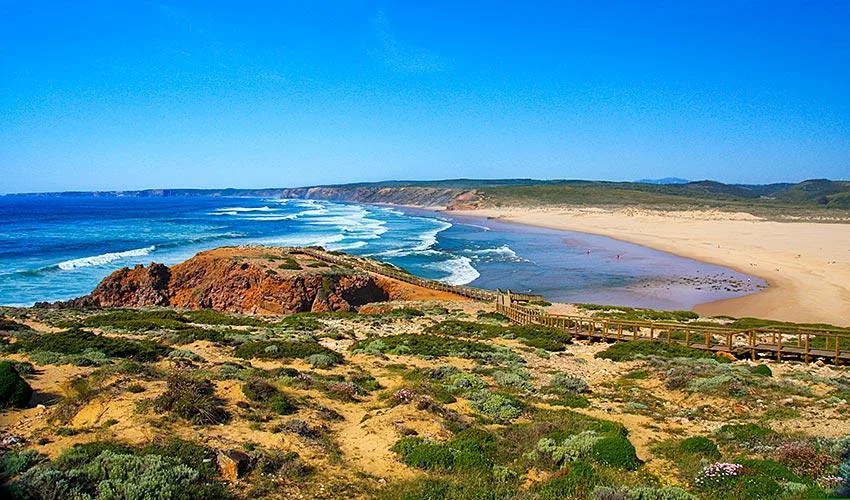The Portuguese Republic is a southern European republic that was created in 1143 and covers an area of 92,212 square kilometers. The mainland is situated in the southwest of the Iberian Peninsula, bordering Spain to the north and east and the Atlantic Ocean to the west and south.
Portugal shares geographical and cultural similarities with countries in both northern Europe and the Mediterranean. It’s cold, rocky northern coast and mountainous interior are sparsely inhabited, picturesque, and wild, but the country’s south, the Algarve, is warm and productive. The craggy Estrela Mountains (Serra da Estrela, or “Star Mountain Range”), located between the Tagus and Montego rivers, include the highest point on continental Portugal. More about Geography of Portugal in Wikipedia.
In addition to the mainland, Portugal has two separate areas. Madeira is a cluster of four islands off the northwest coast of Africa. The main island, commonly known as Madeira, is volcanic and lush, with rugged cliffs and a tropical temperature. Funchal serves as its city.
Table of Contents

Major Cities of Portugal
Portugal has 159 officially designated cities (“cidades” in Portuguese), according to the most recent government records. Though, not all large towns are considered cities. The term “city” is defined primarily on administrative and historical characteristics, rather than population. Many smaller towns are granted city status due to historical significance or development.
There are some major cities which are mostly known by its important and populations.
- Lisbon The Capital and largest city of Portugal
- Porto .This city is known for its rich history and production of wine, and rivers and architecture
- Vila Nova de Gaia This place attracts tourists and visitors who are interested in Wine, history and culture.
- Braga: It’s known for its Rich religious culture.
- Coimbra …………………………….It has one of the oldest university in Europe.
- Amadora a city famous for its pop culture and nice hotels for visitors.
- Guimarães………………………..Birth place of Portugal.
- Aveiro ………………………………it’s called Venice of Portugal due to canals, bridge and color houses.
- Setubal Its known for rich history and natural beauty.
- Faro Capital of Algarve, most known for its beaches.
History and Culture of Portugal
Portugal’s history spans about 400,000 years. Between this and the establishment of the great monarchy during the Age of Discovery, which oversaw the construction of a massive empire, there were several conflicts, different reigns, and a diversity of groups throughout the region. This includes the Moors, Romans, Germanic Visigoths, and the North African/Middle Eastern Umayyad Caliphate. Having becoming the Kingdom of Portugal in 1139, the country can be regarded the oldest nation-state, especially as its borders have barely changed since 1297.
The colonial empire was the longest-lasting of the European empires and preceded the rise of some of the most (in) famous explorers in history, such as Vasco de Gama and Bartholomew Diaz. At its peak, it covered 600 years and comprised what are now 53 countries.

The diverse range of groups and traditions that have dominated the area since prehistoric times have an impact on the culture.
Traditions span from folk dances like vira, corridinho, and fandango, which have a vibrant quick tempo with hand clapping, guitars, and accordions, to music like Fado, which has heartfelt, sorrowful tunes and lyrics. Indeed, in 2011, Fado was included on UNESCO’s Representative List of the Intangible Cultural Heritage of History.
Reasons for Tourists to Travel to Portugal
Understanding the primary factors that influence travelers is crucial given the expansion of the tourism industry and the rise in demand for travel throughout time. Businesses in the industry can rethink and modify their offers to appeal to their target market thanks to this awareness of the reasons behind tourists’ visits. People’s aspirations, values, advantages, and viewpoints are elements that can be utilized to comprehend the primary reasons why travelers choose a particular location.
Travelers’ happiness at the conclusion of their trip may be a factor in their decision to return later and refer friends and family to the location. Accordingly, it is critical that travel destinations take into account a number of factors that affect visitor satisfaction, including the tourist offer, a favorable quality/price ratio, accessibility, mobility, cleanliness, and safety.
The most common reasons people travel to Portugal are for relaxation, fun, and vacations; business and professional travel; visiting relatives and friends; volunteer health care; religious and cultural purposes; and other reasons.

Portugal, a Tourism Destination
When it comes to tourism, Portugal has the potential to draw a significant number of visitors from various markets. The desire for travel is mostly influenced by the geographic proximity of travel destinations and source countries as well as the desire of wellbeing. Still, Portugal’s tourism demand is clearly seasonal, and there isn’t a varied travel option that can reverse this issue, which has been for a number of years.
Even with the attempts to lessen this trait, the reality is that “Sun and Sea” factors still account for the majority of traveler demand, which explains why the nation attracts more visitors during the warmer months and more people spend the night in hotels.
Portugal is a popular travel destination in both Europe and the rest of the world. One of Portugal’s primary socioeconomic sectors, tourism has a very promising future. This examination of Portuguese tourism covers the years 1965 through 2016. Thus, it outlines the primary shifts in Portuguese tourism during the past half-century. The importance of air travel, event planning, and advertising campaigns is highlighted by the increase in demand for tourism and the expanding internationalization of destinations.
In order to trace the development of Portuguese tourism during the previous 50 years, a number of sources have been cross-referenced. The domestic and international marketing initiatives for the destination were organized chronologically, and planning Instruments were consulted. Official statistics were used to build the data collection, which also benefited from the author’s own data gathering and particular information gathered from groups such as the International Congress and Convention Association (ICCA).
Golf courses, marinas, and yachting harbors have been dereferenced since there was a desire to map the different indicators in order to understand the distribution pattern of the supply and demand for tourists in the country as it stands today.